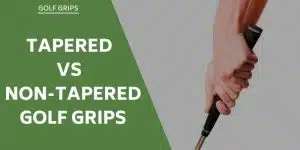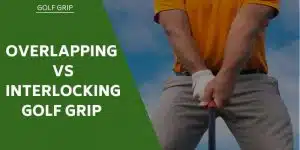In the game of golf, a correct grip is one of the key factors to mastering the art of putting. It’s one of those few components of the golf swing that you have absolute control over. It provides the only physical connection between you and the golf club, and hence, greatly influences the shot’s direction, distance, and trajectory.
So, what is a golf claw grip? The claw grip, also known as the claw putter grip, is a revolutionary alternative to the standard putting grip styles. This unique grip, popularized by the professional golfing circuit, features a unique trailing hand placement that sees the wrist face in the direction of the hole, and fingers rest gently for support.
Without reading the full article, you’ll miss out on a step-by-step guide to mastering the claw grip, an in-depth analysis of its pros and cons, common mistakes to avoid, and a collection of drills to improve your performance.
We’ll delve into the history, variations, and a comparison to traditional grips. We’ll cover its pros and cons, application guide, and cautionary tips. We’ll also offer practice drills, transition advice, answers to common questions, and final reflections on this grip’s usage.
Understanding the Claw Grip
View this post on Instagram
What Is the Claw Grip?
The claw grip is a putting grip where the top hand traditionally grasps the putter while the bottom hand loosely hangs onto the club. Unlike a standard grip, the wrist faces the direction of the hole, and one to four fingers rest on the front to guide the stroke. This unconventional grip style has earned its name, “claw,” due to the unique shape of the hand while grasping the club.
Origins and Evolution of the Claw Grip
The claw grip was popularized in the late 1990s by professional golfer Chris DiMarco. He invented this unique grip style to combat his putting yips. DiMarco’s success with the claw grip spurred other professional golfers to experiment and adopt this alternative grip style, resulting in several variations, such as the pencil putting grip, saw putting grip, and reverse claw putting grip.
How the Claw Grip Differs From Traditional Grips
Unlike the conventional grips, where both hands grasp the putter firmly and work together to swing the club, the claw grip involves a softer, more relaxed hold, especially with the bottom hand. This approach reduces the tendency for the wrists to break down mid-stroke, promoting a smoother and more pendulum-like stroke.
Check out this claw-putting grip golf video for a demonstration.
Benefits of the Claw Grip
The claw grip offers several benefits, making it an attractive option for golfers of all levels. Here are some:
Improved Stability and Control
The unique design of the claw grip puts less stress on the wrists, promoting a more shoulder-dominant stroke. This leads to better stability and control of the putter head, making maintaining a consistent clubface angle and putt straighter lines easier.
Reduced Tension and Increased Comfort
One of the biggest advantages of the claw grip is its ability to reduce tension in the hands and wrists. By essentially taking the lower hand out of the equation, the grip encourages a softer touch and greater feel on the greens, which many golfers find more comfortable.
Drawbacks of the Claw Grip

While the claw grip provides several advantages, it is not without its drawbacks. Here are a few potential downsides to consider:
Unfamiliar Feel
When you first switch to the claw grip, it may feel unfamiliar and uncomfortable. The position of the lower hand, in particular, can feel very strange, as it’s a significant departure from traditional grips. It may take some time and practice to get accustomed to this grip’s feel and start seeing results on the green.
Limited Wrist Action
One of the main goals of the claw grip is to limit wrist action in order to improve putting consistency. However, this can also be a disadvantage for golfers who are used to using their wrists more in their strokes. Such players might struggle initially to generate enough power and may need to adjust their stroke to incorporate more shoulder movement.
Difficulty in Long Putts
Due to its design promoting a pendulum-like stroke, the claw grip can make long putts more challenging. Without the extra wrist action, generating the power needed for long-range putts may be difficult. Golfers using the claw grip might need to adjust their stance or stroke to compensate.
Potential Challenges and Adjustments Needed

Switching to the claw putting grip has pros and cons. Here are some common challenges and advice on how to address them:
Challenge: Adjusting to the New Feel
Adjustment: Patience and consistent practice are key here. It’s important to remember that any change to your golf grip will initially feel strange. Spend some time on the practice green getting used to the new grip. Starting with shorter putts can help build confidence and familiarity before moving to longer ones.
Challenge: Generating Power in Long Putts
Adjustment: If you’re finding it difficult to generate power for long putts, consider adjusting your stance or stroke. Some golfers find that widening their stance or increasing the length of their backswing can help add the necessary power. Another strategy might be to grip the putter a bit firmer with your top hand.
Challenge: Maintaining a Consistent Stroke
Adjustment: Maintaining a consistent and smooth stroke while using the claw grip is essential. The primary movement should come from your shoulders, with minimal wrist involvement. Consider refining your technique by using drills that focus on shoulder movement and pendulum-like stroke consistency.
Overall, while transitioning to a claw grip can present some challenges, with patience, practice, and possibly some professional guidance, you can improve your putting performance and lower your scores.
Steps to Get Started With the Claw Grip

#1. Choosing the Right Putter for the Claw Grip
When transitioning to the claw grip, it is crucial to use a putter with a grip that suits this style. Different putters have varying balances, weights, and lengths, all of which can impact the success of your claw grip. It may be beneficial to try out various putters and choose one that feels the most comfortable and effective in your hand.
#2. Proper Hand Placement and Alignment
Positioning the Top Hand
You should place your top hand (your left hand if you’re right-handed and vice versa) at the top of the grip, with your thumb pointing down the shaft of the club. Ensure the fingers wrap around the grip securely, offering stability without creating unnecessary tension.
Positioning the Bottom Hand
The bottom hand (right hand for right-handers and left hand for left-handers) is the one that adopts the claw-like position in this grip. Position it further down on the grip and move your wrist outward so that it faces the direction of the hole. Next, rest your fingers on the front, the thumb and index finger should be pointing toward the ground.
Balancing Grip Pressure
Balancing grip pressure is essential for a successful claw grip. The grip should be firm enough to maintain control of the putter but not so tight as to create tension in the wrists or forearms, which could hinder the fluidity of the putting stroke.
#3. Establishing a Consistent Putting Routine
Pre-Shot Routine
A consistent pre-shot routine can help you focus, visualize, and execute the shot more successfully. This routine might involve analyzing the green, aligning the shot, and taking a few practice swings before actually hitting the ball.
Stroke Mechanics and Follow-Through
The claw grip encourages a pendulum-like stroke that should remain consistent from start to finish. Ensure your follow-through is smooth and controlled, and that your body remains still throughout the stroke to promote accuracy.
Common Mistakes to Avoid With the Claw Grip

Gripping Too Tightly
Gripping the putter too tightly can create tension in your arms and wrists, potentially affecting your control over the stroke. Aim for a grip pressure that is firm enough for control but relaxed enough for a smooth stroke.
Inconsistent Hand Placement
Hand placement is crucial with the claw grip. Ensure your bottom hand is at the top of the grip and your top hand is in the claw position for each putt. Inconsistent hand placement can lead to variability in your putts and make it harder to establish a reliable stroke.
Neglecting Proper Wrist Alignment
Proper wrist alignment is key to the claw grip. Both wrists should remain flat and avoid excessive hinging or rotation during the stroke.
Overthinking the Technique
While it’s important to understand and apply the mechanics of the claw grip, avoid overthinking each step during a round of golf. Practice the grip and stroke mechanics off the course so that they become second nature, allowing you to focus on the putt at hand during your round.
Practicing and Drills for Improving the Claw Grip
1. Claw Grip Putting Distance Control Drill
This putting distance control drill can help you refine your feel and control over the ball, two crucial elements when putting with the claw grip.
2. Gate Drill for Alignment And Accuracy
The gate drill can help you improve your alignment and accuracy, which are key for successfully putting with the claw grip.
3. Smooth Stroke Drill
This smooth stroke drill is an excellent way to practice maintaining a consistent and smooth stroke, which is vital when using the claw grip.
4. Practicing Under Pressure Situations
This practicing under pressure drill will help you get used to using the claw grip in high-pressure situations, replicating the feelings you might experience during a tournament or competitive round.
Check out our checklist of tips to improve your putting.
Tips for Successful Transition to the Claw Grip
Start With Short Putts and Build Confidence
When transitioning to the claw grip, begin with short putts. As your confidence grows and you become more comfortable with the grip, gradually increase the length of your putts. Remember, confidence is crucial to any successful golf shot, including putting.
Seek Professional Guidance and Feedback
Working with a golf instructor can significantly aid your transition to the claw grip. They can provide real-time feedback, help with adjustments, and ensure that you’re correctly implementing the new grip.
Be Patient and Persistent in the Learning Process
Learning a new putting grip can be challenging and takes time. Try not to get disheartened if you don’t see immediate improvements. Be patient and persistent, and with practice, your performance will improve.
Experiment and Make Personal Adjustments
While there are standard guidelines for the claw grip, every golfer is unique. Don’t be afraid to make slight adjustments to fit your comfort level and playing style.
Adapting the Claw Grip to Chipping and Full Swing Shots

Applying the Claw Grip to Chipping Techniques
While traditionally used for putting, some golfers successfully apply the claw grip to their chipping techniques. This can provide greater control and consistency, especially in short-game situations.
Using the Claw Grip for Full Swing Shots
Applying the claw grip to full-swing shots is less common, but some players may find it beneficial, particularly if they struggle with grip tension or wrist action in their swing. Remember, the key is experimenting and finding what works best for you.
Considerations and Adjustments for Different Clubs
When using the claw grip with different clubs, it’s important to consider the varying club lengths and clubhead weights. Some clubs may require slight grip adjustments to maintain control and accuracy. For example, some golfers prefer using fat putting grips.
Conclusion
The claw grip effectively improves putting performance, reduces wrist action, and controls grip tension. It may require patience to master, but with persistence, it can significantly enhance your game. As you embrace this journey, remember that golf is a game of continuous learning, adaptation, and enjoyment.
Claw Grip: Frequently Asked Questions
Is the Claw Grip Suitable for All Golfers?
Yes, the claw grip is suitable for all golfers, irrespective of skill level. However, its benefits may be more pronounced for those struggling with wrist action or grip tension in their putting stroke.
How Long Does It Take to Transition to the Claw Grip?
The transition period varies among golfers. Some may feel comfortable within a few weeks, while others may need a few months. It largely depends on how often you practice and your ability to adapt to new techniques.
Can the Claw Grip Help With Reducing the Yips?
The claw grip can indeed help with reducing the yips. By changing the way the hands and wrists work during the stroke, the claw grip can alleviate some of the problems associated with the yips.
Do Certain Putters Work Best With the Claw Putting Grip?
There isn't necessarily a specific type of putter that works best with the claw grip. The important thing is to find a comfortable putter. That being said, some golfers find mallet putters or those with larger grips more comfortable when using the claw grip. Check out our list of the best putters on the market.
What Is the Purpose of the Claw Putting Grip?
The claw grip helps reduce wrist action and tension in the hands during the putting stroke. This can result in a smoother stroke and more consistent results.
Is the Claw Grip Good for Putting?
Yes, many golfers have found success with the claw grip in their putting game. It offers greater control, reduces wrist action, and can result in more consistent putts.
Which Professionals Use a Claw Grip?
Several professional golfers use the claw grip, including Phil Mickelson, Sergio Garcia, and Justin Rose, among others. Tiger Woods uses the reverse overlap grip.
Sam has been playing golf for over 20 years and founded Impact Golfer. As a teenager, he discovered his love for the game using his grandad’s clubs, including a wooden driver. As a golf obsessive, Sam plays whenever possible, regularly competing in matchplay with his friends and in tournaments at his local club. He's fortunate to have a close friend who is a club pro– he has tested almost every type of equipment on the market (no freebies yet).
Sam has a handicap index of 13 and likes playing at the Metro Golf Centre near his home in London. He putts with a Taylormade Spider because Rory uses it but regrets selling an old Scotty Cameron putter on eBay.
- Best score: 94
- Favorite club: TaylorMade Stealth Driver
- Favorite putter: Bought a TaylorMade Spider because Rory uses it, but spend most of my time on greens yearning for the Scotty Cameron I sold on eBay.
- Favorite food at the turn: Baguette. Sausages. Bacon. HP Sauce.





![Midsize vs. Standard Golf Grip [Avoid This Big Mistake!]](images/copy-of-copy-of-best-golf-iron-shaft-267x150.png.webp)

